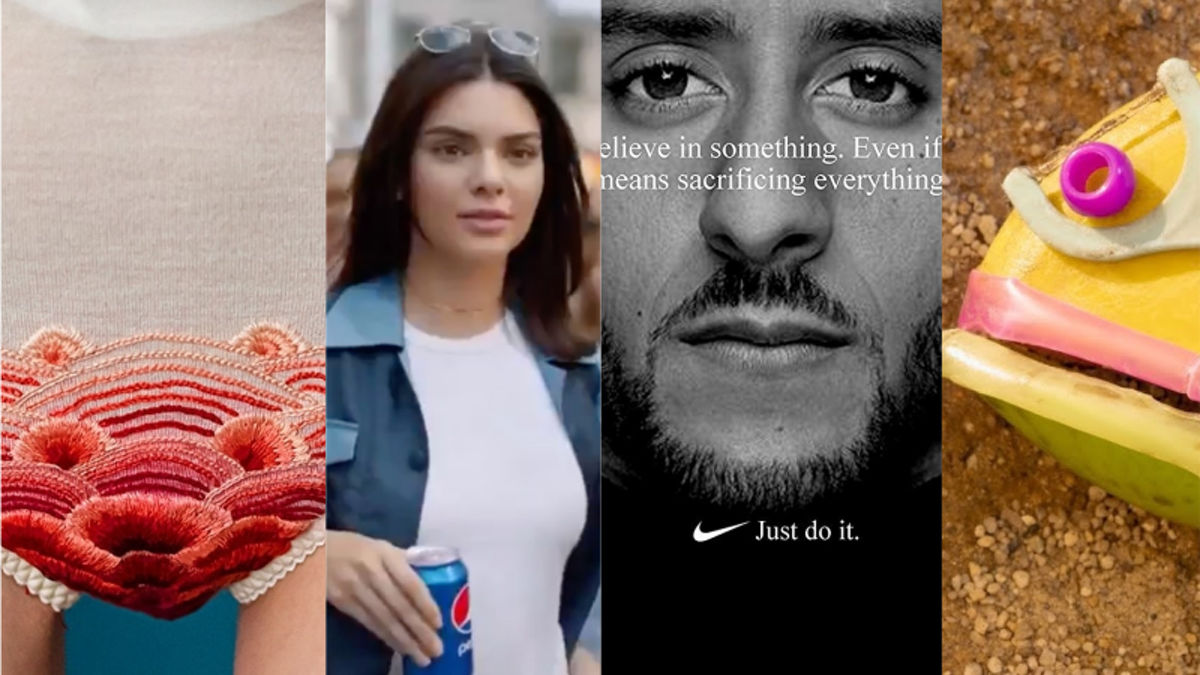Why CSR is not a trend but a new way of doing business
From saving the oceans to gender empowerment, political engagement and beyond, brands are getting involved in conversations they might previously have avoided. With Corporate Social Responsibility now more important than ever, Kate Hollowood investigates which brands are doing it right and how to avoid getting it wrong.
In the past year alone we’ve seen Nike support the fight against racial injustice, Libresse tackle vulva shame [below] and LVMH donate 200 million euros ($226 million) to help repair Paris’ Notre Dame Cathedral.
Credits
powered by
- Agency AMV BBDO/London
- Production Company Somesuch
- Director Kim Gehrig
-
-
Unlock full credits and more with a Source + shots membership.
Credits
powered by
- Agency AMV BBDO/London
- Production Company Somesuch
- Director Kim Gehrig
- DP Deepa Keshvala
- Production Designer Marie Lanna
- Editor Elise Butt

Credits
powered by
- Agency AMV BBDO/London
- Production Company Somesuch
- Director Kim Gehrig
- DP Deepa Keshvala
- Production Designer Marie Lanna
- Editor Elise Butt
Once the job of a single department, CSR has evolved into one of the most widespread communications trends with many brands putting ‘purpose’ at the heart of their advertising strategies. Studies suggest it’s a business imperative that they do so: two thirds of adults globally now buy according to their beliefs and 71% of millennials say they prefer brands that drive social and environmental change.
Very often ['purpose'] is used as a transparent attempt to disguise a lack of substance. That’s why it’s currently getting a bad reputation.
But we’ve also seen brands’ CSR efforts fail miserably. Pepsi, the poster child for purpose gone wrong, humiliated itself with its tone-deaf Kendall Jenner ad trying to champion the right to free protest in 2017. Earlier this year, Gillette’s ad [below] calling for an end to toxic masculinity also sparked tides of criticism, much of which highlighted the fact that the brand still sells a women’s version of its product in pink and for a higher price.
Credits
powered by
- Agency Grey New York
- Production Company Somesuch
-
-
-
Unlock full credits and more with a Source + shots membership.
Credits
powered by
- Agency Grey New York
- Production Company Somesuch
- Post Production MPC New York
- Editing Company Cosmo Street Editorial
- Music Perfect Music, New York
- Sound Design Heard City, New York
- Editor Joshua Berger
- Editor Tom Lindsay
- Director of Photography Adam Arkapaw
- Executive Creative Director Joe Mongognia
- Executive Producer Nicky Barnes
- Head of Production Anne Lai
- Director Kim Gehrig
- Producer Saul Germaine
- Creative Director Patrick Conlon
- VFX Supervisor Thiago Porto
- Colourist Mark Gethin
- Sound Designer Keith Reynaud
- Global Chief Creative Officer John Patroulis
- [group] Creative Director Asan Aslam
- Deputy Chief Creative Officer Jeff Stamp

Credits
powered by
- Agency Grey New York
- Production Company Somesuch
- Post Production MPC New York
- Editing Company Cosmo Street Editorial
- Music Perfect Music, New York
- Sound Design Heard City, New York
- Editor Joshua Berger
- Editor Tom Lindsay
- Director of Photography Adam Arkapaw
- Executive Creative Director Joe Mongognia
- Executive Producer Nicky Barnes
- Head of Production Anne Lai
- Director Kim Gehrig
- Producer Saul Germaine
- Creative Director Patrick Conlon
- VFX Supervisor Thiago Porto
- Colourist Mark Gethin
- Sound Designer Keith Reynaud
- Global Chief Creative Officer John Patroulis
- [group] Creative Director Asan Aslam
- Deputy Chief Creative Officer Jeff Stamp
It’s often touted that purpose fails when the work is not ‘authentic’, a word that is quickly becoming as overused as the word ‘purpose’ itself. To help demystify what it takes for a brand to successfully align with a cause, we speak to a variety of industry leaders about why purpose needs to be much more than just your communications strategy.
Why are you here in the first place?
“'Purpose' has turned into this terrible catch-all buzzword,” says Maximilian Weigl, Strategy Director at 72andSunny Amsterdam, the agency that is helping Axe redefine masculinity [below] and Smirnoff champion LGBT+ rights. “Very often it is used as a transparent attempt to disguise a lack of substance. That’s why it’s currently getting a bad reputation.”
The problems start when there’s a mismatch between a brand’s CSR ambitions and the realities of its business model.
Despite this, most brands want to be genuine about making a positive impact on the world, says Weigl. “The problems start when there’s a mismatch between a brand’s CSR ambitions and the realities of its business model,” he says. “Brands increasingly think they need to associate themselves with a cause, but every brand already has a purpose – which is the reason why they exist in the first place. They already have an ethical standpoint, which manifests in the way they behave as a business and make money.” Many brands, he explains, were created for a purely commercial purpose, while others were built for reasons beyond just money and power.
Credits
powered by
- Agency 72andSunny/Amsterdam
- Production Company Division
- Director Francois Rousselet
-
-
Unlock full credits and more with a Source + shots membership.
Credits
powered by
- Agency 72andSunny/Amsterdam
- Production Company Division
- Director Francois Rousselet
- Strategy Director Danny Feeney
- Strategy Paul Chauvin
- Business Manager Madelon Pol
- MD Nic Owen
- Head of Production Sanne van Hattum
- Executive Producer Peter Montgomery
- Exec CD Carlo Cavallone
- Director of Film Production Stephanie Oakley
- CD Laura Visco
- CD Emiliano Trierveiler
- Senior Designer Mario Guay
- Design Director Richard Harrington
- Business Manager Nickie Stevens
- Executive Producer Jules De Chateleux
- Flame Artist Fred Brandon
- Colourist Simon Bourne
- Editor Amanda James
- Sound Mix Sam Ashwell
- Sound Mix Mark Hellaby
- Music Supervision Tammy Tinawi
- Line Producer Aurelie Bruneau
- DP Nicolas Loir
- Post Producer Guillaume Marien
- VFX Yann Aldabe
- Strategy Director Stephanie Feeney

Credits
powered by
- Agency 72andSunny/Amsterdam
- Production Company Division
- Director Francois Rousselet
- Strategy Director Danny Feeney
- Strategy Paul Chauvin
- Business Manager Madelon Pol
- MD Nic Owen
- Head of Production Sanne van Hattum
- Executive Producer Peter Montgomery
- Exec CD Carlo Cavallone
- Director of Film Production Stephanie Oakley
- CD Laura Visco
- CD Emiliano Trierveiler
- Senior Designer Mario Guay
- Design Director Richard Harrington
- Business Manager Nickie Stevens
- Executive Producer Jules De Chateleux
- Flame Artist Fred Brandon
- Colourist Simon Bourne
- Editor Amanda James
- Sound Mix Sam Ashwell
- Sound Mix Mark Hellaby
- Music Supervision Tammy Tinawi
- Line Producer Aurelie Bruneau
- DP Nicolas Loir
- Post Producer Guillaume Marien
- VFX Yann Aldabe
- Strategy Director Stephanie Feeney
Patagonia, for example, was started by a group of mountain climbers and surfers and cites its reason for being as to “build the best product, cause no unnecessary harm, use business to inspire and implement solutions to the environmental crisis”. At least 1% of its sales or 10% of its pre-tax profits - whichever is more - is donated to grassroots environmental groups every year and the brand’s Worn Wear platform organises the recycling or re-selling of used Patagonia garments. “Because of its history, structure and belief systems, Patagonia seems to be more authentic than many others in this space,” says Patrick Kiss, President of California-based agency Butler Shine Stern & Partners (BSSP).
Deeds are more convincing than words and the brands that take action and make sacrifices will be the ones we believe in.
But does that mean that brands which came from less noble beginnings shouldn’t bother trying to use advertising for good? “It’s much easier to build [CSR] into a company from the beginning than to retrofit beliefs and actions into an established corporate structure,” says Peter Knierim, Creative Director at Fortnight Collective in Colorado. “Some of the biggest brands may have the most resources to make real change, but the hurdles to make it happen are much taller.”
A company-wide overhaul
That’s because for consumers to believe that a brand’s alignment with a cause is genuine, they need to experience its commitment consistently across every interaction and touchpoint; from the marketing campaign and the product itself to the customer service experience.
For many businesses, this requires a complete overhaul. “This is not about a layer of self-congratulatory gloss,” says Darren Bailes, ECD at VCCP London. “This is about re-engineering a brand’s DNA, from top to bottom. A whole organisation needs to care.”
When a brand’s business model is entangled with a social issue, finding the right partnerships and knowing which corners to fight becomes much easier.
Some big companies are rising to challenge. Working with Wieden+Kennedy Amsterdam, Corona has joined the fight against plastics in the ocean. In May 2017, the beer company aligned with charity Parley for the Oceans and made a commitment to protect 100 islands by 2020. The first year of the partnership focused on working with local communities to avoid plastic use. More recently, for Earth Day 2019, Corona launched the Fish, a stop-motion animation in which washed-up plastic waste joins together to create a fish, which a seagull then tries to eat.
Credits
powered by
- Agency Wieden + Kennedy/Amsterdam
-
- Director PES
-
-
Unlock full credits and more with a Source + shots membership.
Credits
powered by
- Agency Wieden + Kennedy/Amsterdam
- Director PES
- Sound Designer/Audio Mixer Dave Wagg
- Executive Creative Director Eric Quennoy
- Executive Creative Director Mark Bernath
- Creative Director Alvaro Sotomayor
- Art Director Anyaa Dev
- Art Director Riccardo Rachello
- Head of Broadcast Production Joe Togneri
- Planner Maria Correa
- DP Eric Adkins
- Executive Producer Sarah Phelps
- Production Designer Kyle Arneson
- Art Department Lead Greg Pinsoneault
- Animator Javan Ivey
- Animator Alfonso Estrada
- Editor Brian Miller
- VFX Supervisor Andrew Babick

Credits
powered by
- Agency Wieden + Kennedy/Amsterdam
- Director PES
- Sound Designer/Audio Mixer Dave Wagg
- Executive Creative Director Eric Quennoy
- Executive Creative Director Mark Bernath
- Creative Director Alvaro Sotomayor
- Art Director Anyaa Dev
- Art Director Riccardo Rachello
- Head of Broadcast Production Joe Togneri
- Planner Maria Correa
- DP Eric Adkins
- Executive Producer Sarah Phelps
- Production Designer Kyle Arneson
- Art Department Lead Greg Pinsoneault
- Animator Javan Ivey
- Animator Alfonso Estrada
- Editor Brian Miller
- VFX Supervisor Andrew Babick
“When we first talked to Corona about plastic, it was because the brand is associated with the beach. If there’s no beach for people to enjoy anymore, that’s not good for the brand,” says Blake Harrop, Managing Director at Wieden+Kennedy Amsterdam.
“Getting not only Corona’s commitment to invest in beach clean-ups, but also their partnership with Parley off the ground, and seeing parent company ABI commit to removing all plastic from their supply chain by 2025 gave us confidence that the commitments are genuine.” The partnership has already had an impact in several regions around the world, with more than 25 islands now under protection in the Maldives.
Nike’s stock increased by 5% in the weeks after the commercial was first aired, resulting in a $6 billion increase in overall value.
When a brand’s business model is entangled with a social issue, finding the right partnerships and knowing which corners to fight becomes much easier. “If the brand is truly committed to their cause, then it’s not hard because they’ll already be a part of the community,” says Harrop. “For example, Nike exists to serve the athlete, so it stands to reason that any issues that athletes are facing, Nike will already be aware of and involved in.”

Last year, the agency’s outpost in Portland worked with Nike to make American football quarterback Colin Kaepernick the face of a new campaign. The sports star had previously caused controversy by kneeling on pitch during the US national anthem in a protest against racial injustice and police brutality. Alluding to this defiant gesture, Kaepernick states in the ad, “Believe in something. Even if it means sacrificing everything. Just Do It.” Nike’s stock increased by 5% in the weeks after the commercial was first aired, resulting in a $6 billion increase in overall value.
Get ready for the haters
The Kaepernick work illustrates another prerequisite of successful purpose-driven marketing: you need to be prepared to piss people off. “You're leaping into the middle of some very emotive, divisive issues that can get ugly, fast. So, a brand needs to be fully committed to their stance,” says David Billing, CCO, The Beyond Collective London. Some people were so outraged by Nike’s campaign that they started destroying their trainers and posting online with the hashtag #justburnit and #BoycottNike.
Credits
powered by
- Agency Wieden+Kennedy Portland/United States of America
- Production Company Park Pictures
-
-
-
Unlock full credits and more with a Source + shots membership.
Credits
powered by
- Agency Wieden+Kennedy Portland/United States of America
- Production Company Park Pictures
- Director Lance Acord

Credits
powered by
- Agency Wieden+Kennedy Portland/United States of America
- Production Company Park Pictures
- Director Lance Acord
Bodyform’s Blood Normal campaign by AMV BBDO London [below] also provoked backlash when it showed red, rather than blue, menstrual blood in its ad in a bid to tackle period taboos. The film shows a montage of clips trying to normalise periods, from red blood trickling down a girl’s leg while in the shower to a guy buying sanitary products for his girlfriend. The commercial was banned from TV with broadcasters claiming the sight of period blood was unacceptable.
As Gen Z gain purchasing power, the need for brands to prove that they are a positive force in the world will likely only become more vital.
Bodyform launched the film online anyway. While some members of the public voiced their revulsion on Twitter [“This is what happens when whores and pimps become marketers”, is one sample tweet] overall sentiment around the message was 72% positive. The brand received an outpouring of gratitude and support from women around the globe who admired its commitment to live by its ‘Live Fearlessly’ positioning.
A study by BSSP suggests that backlash against brands getting involved with divisive issues doesn’t necessarily do them long-term harm. Examining reactions to social initiatives by Starbucks, such as a stated goal of hiring 10,000 refugees for their organisation, the agency saw that initial spikes of negativity quickly faded and never impacted the overall health of the brand. “People understood that standing up for certain social issues was a central part of the Starbucks brand,” says BSSP’s Patrick Kiss.
Credits
powered by
- Agency AMV BBDO/London
- Production Company Somesuch
- Director Daniel Wolfe | (Director)
-
-
Unlock full credits and more with a Source + shots membership.
Credits
powered by
- Agency AMV BBDO/London
- Production Company Somesuch
- Director Daniel Wolfe | (Director)
- Producer Edwina Dennison
- Executive Creative Director Alex Grieve
- Executive Creative Director Adrian Rossi
- Creative Partner Toby Allen
- Creative Partner Jim Hilson
- Copywriter Nicholas Hulley
- Art Director Nadja Lossgott
- Art Producer Kirstie Johnstone
- Joint Chief Strategy Officer Bridget Angear
- Planner Margaux Revol
- Project Manager Leonie Chaudhry
- Music Felt Music
- Audio Post Sam Ashwell
- Editor Tom Lindsay
- Post Production The Mill/London
- Post Production Framestore/London
- Executive Producer Lou Hake
- Producer Tim Nash
- Account Exec Sarah Douglas
- Producer Sally Llewellyn
- DP Monika Lenczewska
- Planners Rebecca Fleming

Credits
powered by
- Agency AMV BBDO/London
- Production Company Somesuch
- Director Daniel Wolfe | (Director)
- Producer Edwina Dennison
- Executive Creative Director Alex Grieve
- Executive Creative Director Adrian Rossi
- Creative Partner Toby Allen
- Creative Partner Jim Hilson
- Copywriter Nicholas Hulley
- Art Director Nadja Lossgott
- Art Producer Kirstie Johnstone
- Joint Chief Strategy Officer Bridget Angear
- Planner Margaux Revol
- Project Manager Leonie Chaudhry
- Music Felt Music
- Audio Post Sam Ashwell
- Editor Tom Lindsay
- Post Production The Mill/London
- Post Production Framestore/London
- Executive Producer Lou Hake
- Producer Tim Nash
- Account Exec Sarah Douglas
- Producer Sally Llewellyn
- DP Monika Lenczewska
- Planners Rebecca Fleming
Put your money where your mouth is
Brands can earn respect by proving that they care more about a given issue than their own bottom lines. “Deeds are more convincing than words and the brands that take action and make sacrifices will be the ones we believe in,” says Alan Young, Chief Creative Officer at St. Luke’s London, which worked with cider brand Old Mout to help take the kiwi bird off the endangered species list. “People know a principle is never really a principle until it costs you money.”
VCCP’s Bailes also emphasises that for a brand to effectively align itself with a cause, cost is inevitable in the short term. “That pain will hurt and test commitment. But it will be nothing to the cost of losing market share when a funky independent start-up with a big heart and a strong mission rocks up and kicks your ass.”
Don’t get carried away - it’s advertising
A word of warning, however: a brand’s lofty advertising ambitions should always be accompanied with a slice of humble pie. “Brands should not overestimate their value and expertise or fall foul of the ‘saviour’ complex,” says Melissa Parsey, Head of Strategy at New York consultancy, co:collective.
Instead, they should use their platform and reach to elevate and accelerate the work of their partners who don’t have that power. Nike, she believes, was successful because it gave a Colin Kaepernick “a global stage to play on, when he was denied access to the field”.
Business’s social responsibility is more important than ever before, and one that not only the creative department should be taking seriously.
And, in their eagerness to create meaningful work, marketers mustn't overestimate the extent to which their customers care, either. Amazon is one of the most powerful companies in the world today despite its questionable working practices and culture. “For a lot of categories, the core utility and price are going to be the deciding factors for most consumers,” says Wieden+Kennedy Amsterdam’s Harrop. “We work with Ørsted, one of the world’s largest sustainable energy companies, and we know that very few people are looking to pay a higher electricity bill.”
A growing responsibility
However, as Gen Z - the most socially and environmentally conscious generation to date - gain purchasing power, the need for brands to prove that they are a positive force in the world will likely only become more vital.
Furthermore, with many governments and NGOs failing to inspire or deliver positive change, people will increasingly look to brands to fill their shoes. “From the decisions that social media companies make on data privacy, to the use of Palm Oil in shampoo and makeup, today commercial enterprise has the power to influence the course of the world in a way we haven’t seen since the 18th and 19th centuries,” says Emma De La Fosse, Chief Creative Officer at Digitas in London.
Business’s social responsibility is more important than ever before, and one that not only the creative department should be taking seriously.
)
















